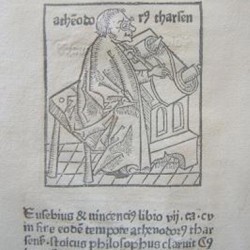By Helen Figueira
October 3, 2011
Time to read: 5 minutes
 Bryony Graham pens story of genes’ secret scribe
Bryony Graham pens story of genes’ secret scribe
The scribe sits scribbling furiously, sweat beading on his brow. He has to produce an entire copy of the text in front of him in a ludicrously short period of time, and he is feeling the pressure. He has no complex, automated technology to help him – just his own flesh and blood. Inevitably, he begins to make mistakes. He is only human, after all.
The text in question is the instruction manual which can build a human; it is your genome. Each individual on the planet has their own, unique text (with the exception of identical twins) and there is a copy inside every one of the thousands of cells which make up your body. These cells are constantly being replaced, and every time a cell divides it has to produce an exact replica of the genome – a text composed of 3 billion letters.
Clearly this is no mean feat. And the cell makes mistakes. But it also has the means to correct them, to proof read the genome. This process is critical to our health – if mistakes are allowed to accumulate, the cells become cancerous. Scientists now know that this accumulation is not specific to one type of tumour; it is the fundamental mechanism underlying every form of the disease. Understanding what causes these mistakes and why they are not corrected is therefore essential to the development of therapies which could potentially target not one, but many forms of cancer. And, during the course of my PhD, I am hoping to contribute to this understanding.
But I’m not actually interested in the mistakes in the text itself. I want to know what happens if someone tries to scribble all over it, or pull out a bookmark, or fold over the corner of a page. Even if the sequence of letters is identical, if the text is annotated differently – its meaning could be completely changed.
You see, although every cell in your body has the same copy of the genome, each cell bookmarks it in distinctively. It is these annotations, collectively referred to as epigenetics, which allow different cells in your body to have unique, specific functions despite having the exactly same copy of the instruction manual. So, when a cell needs to produce an identical copy of itself, it does not only have to copy the genome – it has to copy the bookmarks too. During the course of my PhD, I’m hoping to find out how a cell does this. How stable are these marks? How are they copied when a cell divides? What happens if cells make mistakes in where they put the bookmarks?
Using stem cells taken from mice and grown in a laboratory, I have identified tiny molecules inside cells which are passed on from a parent cell to its progeny. If these molecules aren’t there when the cell divides, its descendents start to read all sorts of bits of the genome they shouldn’t; bits that should only be read in brain cells, or blood cells, or bone. So, these molecules somehow act to help the stem cell pass on its identity; to allow its progeny to remember their purpose in life. Are these molecules related to the bookmarks? Do they help tell the cells where the bookmarks are supposed to go? Or do they work in collaboration with the scribe directly, helping to copy the genome? I don’t yet know. But what I do know, as a result of the work of other scientists, is that in tumours, these molecules are often changed or absent. So I’m pretty keen to find out.
Epigenetics is a new and exciting field which has not only revolutionised classical genetics, but could add critical information to our understanding of how and why, at the most fundamental level, we develop cancer. All over the world, scientists are working on different tumours from different parts of the body from different patients. But what is common to them all is that somehow, at some point, the scribe has messed up and a mistake has occurred in the genome. It could be a change to the sequence of the letters, a fold where there shouldn’t be one, or a misplaced bookmark. I want to know what goes wrong to allow this mistake to be passed on to the next generation of cells. This could hold the key to understanding why tumours develop, and how we can treat them – even if we cannot stop the mistakes happening in the first place. We are only human, after all.
Bryony Graham
Lymphocyte Development PhD student Bryony Graham’s essay How to proof read a genome was shortlisted for the 2011 MRC Max Perutz award. She joined other shortlisted authors and MRC Chief Executive Sir John Savill at a prizegiving ceremony at the Royal Society on 7 September. Her essay is one of 12 to be featured in a book of the year’s shortlisted entries, currently being published.